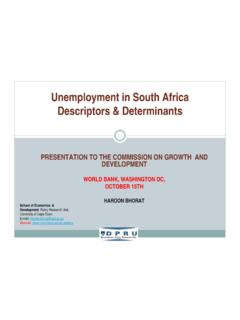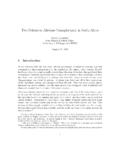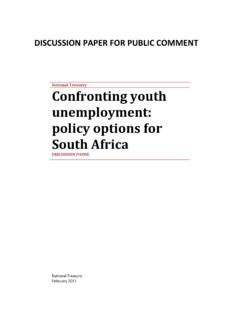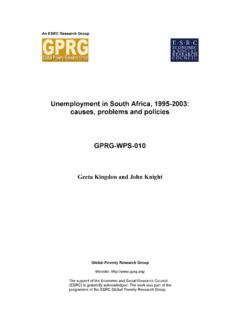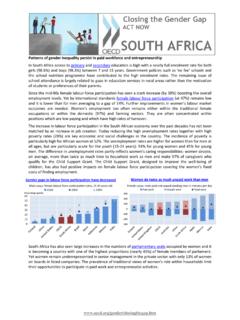Transcription of Youth unemployment in South Africa: causes and …
1 Entry No: 1494. Youth unemployment in South africa : causes and counter-measures South africa is currently struggling with large unemployment amongst the Youth . The National Development Plan has identified a number of policy interventions to improve Youth employment. In your view, what are the causes of Youth unemployment and what should government do to improve the levels of Youth employment? Identify the pros and cons of each of your proposals. Word count: 2200 words (incl. footnotes, excl. headings, references, & in-text references).
2 Undergraduate Page 1 of 13. Entry No: 1494. 1. Introduction unemployment is arguably the single most significant obstacle to poverty reduction in South africa (Ligthelm, 2006:30). The incidence of unemployment falls most harshly on young South Africans, who are generally low-skilled and have little to no experience of formal employment (National Treasury, 2011:12). It is exceedingly difficult for one of these unemployed young people to exit unemployment , and it is expected that a significant number of today's unemployed Youth will never achieve formal sector employment (National Planning Commission, 2012:106).
3 The National Development Plan (NDP) (National Planning Commission, 2012) seeks to address this significant issue by suggesting a number of policies which may reduce Youth unemployment . This paper will argue that one of the NDP's more controversial policies, that of a Youth wage subsidy, is a worthwhile policy and should be implemented, but with a regulated dismissal period. It will also argue that the government should encourage the growth of the South African informal sector. Section 2. describes the nature of unemployment in South africa , and section 3 goes on to analyse the causes of Youth unemployment .
4 Section offers a broad approach within which unemployment -reduction policies should be theorised, and will then briefly outline the two most significant unemployment -reducing processes, education and economic growth, before explaining how intermediary policies are needed while these two processes develop. In section the Youth wage subsidy will be introduced and analysed, and the modified version put forward. The paper will end by discussing the role that South africa 's currently stunted informal sector could play in reducing Youth unemployment .
5 2. Characterising unemployment in South africa The South African labour market is characterised by significantly high levels of unemployment compared to other emerging-market economies (National Planning Commission, 2011:12-13). The South African labour force makes up just of the global labour force, but accounts for 2% of the world's unemployment (National Treasury, 2011:13). The local labour-force participation rate of is significantly lower than the rates of comparable countries (National Planning Commission, 2011:13), and the labour absorption rate of the formal economy has steadily declined since 1985 (Ligthelm, 2006:37), as Table 1 shows.
6 However these broad pictures of unemployment do not reflect the sectional differentiation evident in the South African labour market. In particular, while the employment of non- Undergraduate Page 2 of 13. Entry No: 1494. youths in South africa is low compared to comparable emerging-market levels (8 percentage points lower), Youth employment in South africa is much lower still (24 percentage points lower), with further investigation emphasising this divergence (National Treasury, 2011:12). Less than 17% of people over age 30 are unemployed in South africa , compared to 42% for people younger than 30 (National Treasury, 2011:5).
7 Figure 1 illustrates that the incidence of unemployment falls largely on young people. Unemployed Youth in South africa are generally low-skilled and have little experience of employment, with two thirds of young people having never worked (National Treasury, 2011:5). Youth unemployment is a particularly serious issue in South africa because the country is experiencing a Youth bulge (National Planning Commission, 2012:98), which presents opportunities for growth if young people are meaningfully employed (McKinsey Global Institute, 2010:3), and the potential for serious social instability if they are not (National Planning Commission, 2012:106).
8 More generally there are a plethora of reasons as to why unemployment is a negative phenomenon, from simple welfare effects, to output effects and other social consequences (Yu, 2012b:13). 3. The causes of Youth unemployment Up until 1994, numerous market distortions were caused by the industrial and social policies of the Apartheid government, with the effects of these distortions remaining evident in South africa today. Import Substitution Industrialisation induced an uncompetitive, capital- intensive economy, from which the majority of South Africans were excluded due to racial spatial policy and other measures (National Planning Commission, 2011:5).
9 The relevant legacies of the Apartheid economy upon democratisation were uncompetitive primary and secondary industries which have consistently shed jobs since 19941 (National Planning Commission, 2011:13), and an unskilled, spatially misaligned labour force, with the majority of South Africans having been denied quality education (National Planning Commission, 2012:110, 114). South African economic growth has occurred largely in skills-intensive sectors, such as the financial and business services sector (Hausmann, 2008).
10 It is generally accepted that the primary cause for South africa 's widespread unemployment today is a structural mismatch between the skills the modern South African economy demands, and the skills it supplies (Hausmann, 2008) (National Planning Commission, 2011:15), with the ratio 1. 2004 mining employment was 29% lower than 1994 levels; 2004 agricultural employment was lower, and manufacturing sector employment declined (National Planning Commission, 2011:9). Undergraduate Page 3 of 13. Entry No: 1494.

